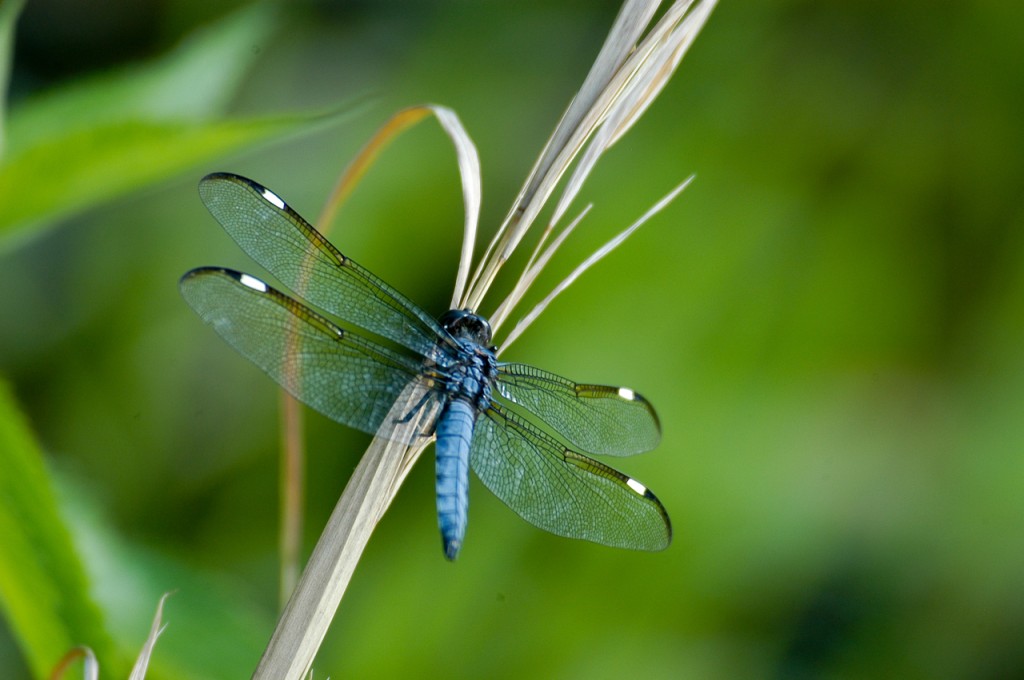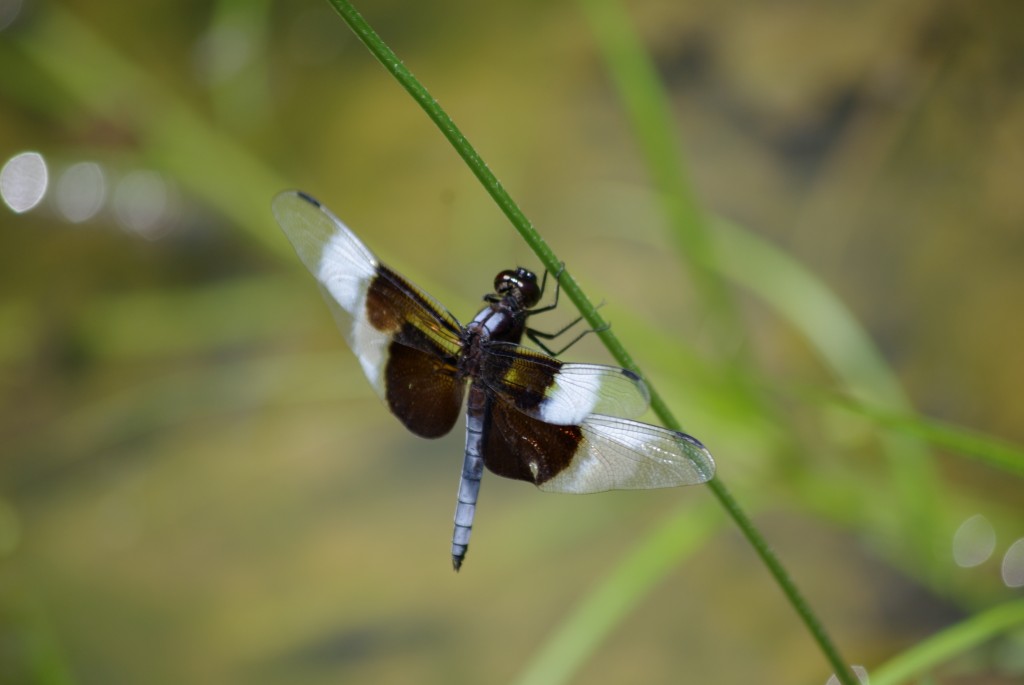Ancient Dragonflies Live Like There’s No Tomorrow
A folklore story, of uncertain origin, tells that there once was a community of little water bugs living in a small pond, in the muddy water, under the lily pads. They lived a simple and comfortable life in the pond with few disturbances and interruptions. Once in a while, sadness would come to the community when one of their fellow bugs would climb the stem of a lily pad and never to be seen again.
They knew when this happened: their friend was dead, gone forever. Then, one day, one little water bug felt an irresistible urge to climb up that stem. However, he was determined that he would not leave forever. He would come back and tell his friends what he had found at the top.
When he reached the top and climbed out of the water onto the surface of the lily pad, he was so tired, and the sun felt so warm, that he decided he must take a nap. As he slept, his body changed and, when he woke up, he had turned into a beautiful blue-tailed dragonfly with broad wings and a slender body designed for flying. So, fly he did!
And, as he soared he saw the beauty of a whole new world and a far superior way of life than he had never known existed. Then he remembered his bug friends and how they were thinking that he was dead. He wanted to go back to tell them, and explain to them that he was now more alive than he had ever been before. His life had been fulfilled rather than ended. But, his new body would not go down into the water. He could not get back to tell his friends the good news. Then he understood that their time would come, when they, too, would know what he now knew. So, he raised his wings and flew off into his joyous new life.
Dragonflies have long captured the attention of humankind. But this interest is fraught with mixed emotions of love or loathing, fascination or fear, all harkening back to ancient cultural perceptions of dragons-on-the-wing.
To the Japanese, the dragonfly symbolizes summer and autumn and is admired and respected universally, so much so that the Samurai used it as a symbol of power, agility and best of all, victory. In China, people associate the dragonfly with prosperity, harmony and as a good luck charm. Amongst Native Americans, it is a sign of happiness, speed and purity. Purity because the dragonfly seems to eat from the wind itself.
In Europe, dragonflies more often have been seen as sinister. English common names such as “horse stinger,” and “devil’s darning needle,” link them with evil or injury. Swedish folklore holds that the devil uses dragonflies to weigh people’s souls, In Portugal they are still sometimes called “eyes-snatcher.” And, the Welsh called them “snake servants.”
Ancient cultural perceptions notwithstanding, nowadays most folks are mesmerized by dragonflies. Perhaps it’s rooted in medieval myth and magic; after all, they are flying little dragons. They are among the oldest insects, inhabiting earth for 300 million years. Fossil evidence shows that several hundred million years ago some dragonfly species had 30-inch wingspans. Now that’s a flying dragon that would grab your attention at a lakeside picnic.
Maybe their simple beauty appeals to us: flying gems, with scintillating, varied iridescent colors and delicate wing patterns gleaming in the sunlight, hanging like threads, loosened from the sky.
We marvel at dragonfly flying skills. They can move easily in six directions — front-back, up-down, and side-to-side — at speeds up to 35 MPH, and have been observed at 7,000 foot altitudes. And while a hummingbird has equal aeronautical agility, with a pair of wings beating at 80 times a second, a dragonfly’s four wings are much more powerful, beating only 30 times a second, but each wing independently adjustable for pitch and speed.
An adult dragonfly’s lifestyle and simple attitude appeals to a some of us. Feisty and territorial, they live out their short month-long lifespan as if there were no tomorrows, with only two preoccupations: eating and breeding.
But perhaps a more debatable explanation for our interest in dragonflies lies in our evolutionary roots, our primordial musings, our innermost “Pleistocene” memories, when we first walked the ice fields, competing for survival.
We’ve got a neighbor who illustrates the concept. He has a fine house and finer shed, surrounded by five acres of lawn with a beautiful sinkhole pond. He keeps pretty much to himself; his wife stays mostly in the house and he stays mostly in the shed. In summer, he assiduously mows the lawn two or so times a week, grooming it to rival a putting green at Pebble Beach or St. Andrews.
About a decade ago I found him on his riding lawnmower stuck in a ditch on the edge of his immaculate lawn. I helped him out of the ditch and took the opportunity to ask him why he mowed so frequently. He said it gave him quiet, quality time away from his wife. So I assumed, for him at least, the “me Tarzan, you Jane” delineations of patriarchy and matriarchy were clearly defined.
A year later I found him stuck in the same ditch, helped him out, and asked the same question about mowing again. He said that in all truth he kept the grass very short because he feared snakes and cougars could hide in it and creep up to the house. It was an honest response, rooted in ancient fears.
Now this same guy has a beautiful, metallic blue Dodge Ram pickup truck. He keeps it so polished and clean that you need sunglasses to dare to look at it. I noticed a couple of summers ago that he started parking it in various odd spots all over his lawn. He called a short time later and asked me to come over and look at something — he needed some help.
He showed me the pickup truck and complained that birds had begun to poop all over the hood, regardless of where he parked. It didn’t really look like bird droppings and he hadn’t a tree on his finely mowed acreage. We watched from his front porch for awhile.
Lo and behold, in a short time, the mystery was solved. Female dragonflies were bombing his truck hood with thousands of eggs, convinced, in their own primordial instinctive way, that the shiny blue hood was a welcoming waterway. The neighbor was transfixed and has since planted aquatic grasses as perches around his pond and added a park bench. In summer now, the truck is in the shed and he and his wife spend much time on the bench, enjoying watching dragonflies.
If you are interested in learning more about dragonflies, Clifftop is hosting a seminar on their natural history on Saturday, February 6th, from 1 to 3 PM, at the Monroe County Annex Building, 901 Illinois Avenue, in Waterloo. Washington University’s Dr. Joe Roti Roti and his wife Pat, who devote much of their time to studying dragonflies, will lead the seminar. It is free and open to the public. Reservations are required by February 4th at clifftop@htc.net or 458-4674.
CLIFFTOP, a local nonprofit organization, is focused on preserving and protecting area bluff lands.
A version of this article appeared in the 15 January 2016 edition of the Monroe County Independent.
© 2016 all content rights reserved Clifftop NFP
Comments are currently closed.


